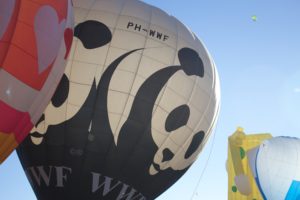“Money makes the world go round,” or so says a modern aphorism. It is as true for conservation as it is for all of us. Conservation leaders recognized that truth in 1961, when they came together to form what we now call the WWF, or, perhaps, “you know, those panda folks.”
Conservation groups weren’t common in 1960, especially at the global level. Two well established groups—the International Union for the Conservation of Nature (IUCN) and the Conservation Foundation—decided that although it was necessary that people care about nature and know how to help preserve it, that wasn’t sufficient. They also needed the money to do it. In April, 1961, those two organizations brought leading conservationists together from 11 nations at Morges, Switzerland. They issued a joint statement, now called the Morges Manifesto, that reads in part this way:
“All over the world today vast numbers of fine and harmless wild creatures are losing their lives, or their homes, in an orgy of thoughtless and needless destruction…. Skilful and devoted men and admirable organisations are struggling to Save the World’s Wild Life. They have the ability and the will to do it but they tragically lack the support and resources…. Hundreds of thousands of people have bought best-selling books and millions have watched films and television programmes about the world’s endangered wild life. Many of these have felt: ‘If only I could do something to help!’….Such a means is now being created….”
The means was the World Wildlife Fund (WWF), which opened its doors in Morges, Switzerland, on September 11, 1961. The organization committed itself to an aggressive and continuiing fundraising campaign and then quick action to distribute funds to worthy projects. In the first year, the WWF awarded $37,500 ($310,000 in today’s money) to five projects addressing the conservation of the Bald Eagle, the Hawaiian seabirds, Guatemala’s Giant Grebe, Canada’s Tule Goose and the red wolf.

Since then, the WWF has blossomed into the largest conservation organization in the world. Since 1985, it has invested over $1 billion through 12,000+ conservation projects of all kinds around the world. It originated the concept of debt-for-nature, allowing developing countries to swap some national debt in exchange for protecting important wildlife habitat. It pioneered the idea of sustainable certifications for forestry and marine fishing operations. It has purchased millions of acres of precious and vulnerable habitats around the globe. Working through partner organizations, businesses and governments, it leverages funds to optimize its impact.
Today, the WWF operates through 40 national affiliates and operates projects in more than 100 countries. It boasts 25 million followers on social media and 5 million financial supporters. In 1917 alone, it invested nearly $160 million directly into conservation projects. WWF operates in six strategic areas: wildlife, oceans, forests, freshwater, climate and energy, and food, chosen and operated in concert with the world’s sustainable development goals. It has identified 35 priority regions/resources, including three in the United States—the northern Great Plains, Chihuahuan Desert and its freshwater resources, and southeastern rivers and streams.
At its founding, the WWF made one other extremely important decision. They chose the giant panda as their logo. According to their website, “Aware of the need for a strong, recognisable symbol that would overcome all language barriers, WWF’s founders agreed that the big, furry animal with her appealing, black-patched eyes would make an excellent logo.” They also wanted a logo that could be printed in black and white to reduce costs. The logo was based on Chi-Chi, a giant panda newly sent from China to the London Zoo in 1961. Wildlife artist Peter Scott, a WWF founder, drew the logo for the new organization. And the rest, as they say, is history.
References:
Warta, Tamara. World Wildlife Fund History. Lovetoknow. Available at: https://charity.lovetoknow.com/World_Wildlife_Fund_History. Accessed July 19, 2018.
World Wildlife Fund. History. Available at: https://www.worldwildlife.org/about/history. Accessed July 19, 2018.
World Wildlife Fund. 2017. WWF Annual Report, 2016. Available at: http://d2ouvy59p0dg6k.cloudfront.net/downloads/wwf_int_annual_review2016_lowres__1___1_.pdf. Accessed July 19, 2018.
World Wildlife Fund Global. 50 years of environmental conservation. Available at: http://wwf.panda.org/knowledge_hub/history/. Accessed July 19, 2018.
